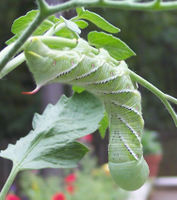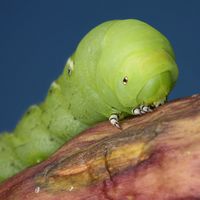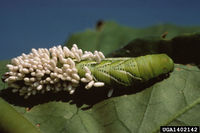Manduca sexta
| Literature database |
|---|
| 222 articles sorted by: |
| • year (descending) |
| • research topics |
| • countries/regions |
| • host plants |
| • list of natural enemies |

Author(s): Daniel Schwen
Source: Wikimedia Commons
Manduca sexta (Linnaeus) - (southern tobacco worm)
This species of hornworms is common in the Americas, especially in warmer regions. The large caterpillars attack solanaceous crops like tomato, tobacco or green pepper. Although the tobacco hornworm can quickly defoliate a plant, it is better known as an easy-to-rear model organism for courses and laboratory studies. In the field, yield losses have been mainly reported from tobacco and tomato.
The development from egg, through 5 larval stages, to adult lasts about 1 to 2 months. For pupation, the caterpillar leaves its host plant and searches for a suitable site to enter the soil and construct an underground pupal chamber. There are typically 2 generations per year, 3-4 generations in some regions.
Insecticides are often applied for control, but should be used with caution as natural enemies are important like the parasitoid Cotesia congregata. It is also susceptible to various Bt products, especially those containing the Cry1A toxin. The pupal chambers are located close to the soil surface and normal soil tillage will control most of the pupae.
| Vernacular names | |
|---|---|
| • Deutsch: | Tabakschwärmer |
| • English: | southern tobacco worm tobacco hornworm |
| • Español: | gusano verde del tabaco |
| • Français: | sphinx du tabac |
| • Português: | esfinge-da-batatinha |
The caterpillars can reach a length of 8 cm and are bright green with characteristic diagonal white lines on the sides. With their green colour, they are well concealed inside the foliage of their host plant. The older caterpillars have a red pointed dorsal structure on the last abdominal segment (the "horn"). The adults have a wing-span of around 10 cm. The forewings are mottled grayish to brownish and the hindwings are light gray with darker bands. The abdomen has 6 pairs of yellowish spots.
Synonyms:
Phlegethontius sexta
See also the closely related tomato hornworm Manduca quinquemaculata.
- Other images of Manduca sexta (Wikimedia Commons and IPM Images - click to enlarge)
caterpillar parasitized by Cotesia congregata




